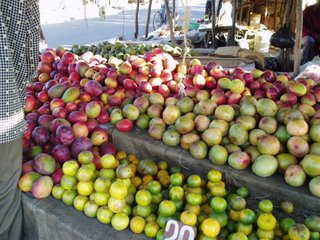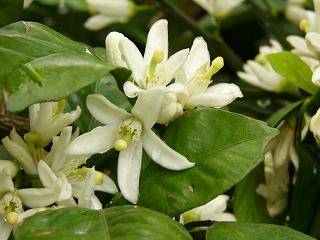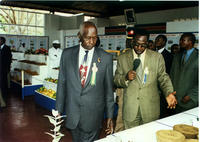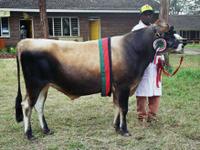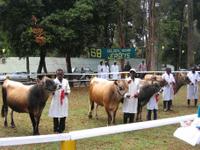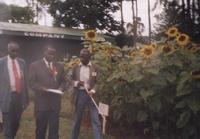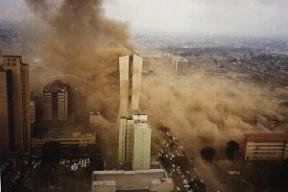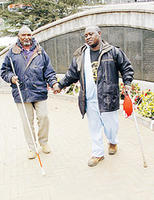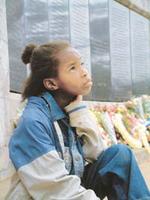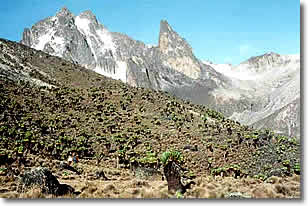[ . BACK to WORLDKIGO . TOP . ]:::::::::::::::::::::::::::::::::::::::::::::::::::::::::::::::::::::::::::::::::::::::::::::::::::::
Meeting of the Haiku Clubs of Nairobi November 2006
ObjectiveThe four Haiku Clubs of the Kayole secondary schools had their second big meeting on Saturday, 4 November 2006. At the invitation of the local community’s Tujisaidie Self-Help Group, the meeting took place in the Community Centre, where the Tujisaidie Nursery School is also based.
The first meeting had been a festive gathering and ginkoo, with participation from invited guests, including the Japanese Cultural Centre. This second meeting was an internal affair, called above all to present the computer students with encouragement and small prizes, and also to have a discussion on haiku writing among ourselves.
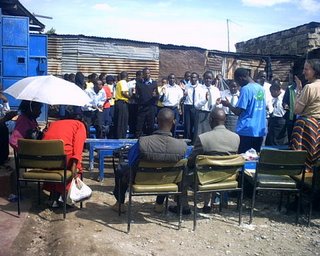 Photo : Patrick WafulaBackground
Photo : Patrick WafulaBackground
During the previous week, I had visited the Bamboochas of Bahati Community Centre taking their computer classes. I had also been invited to the Peacocks of St Mathew Secondary School, to discuss their Ramadhan haiku with them and gather information for the Ramadhan kigo page. The next week would take me to the Falcons of Lorna Waddington High School. I had been received with a lot of cheer, welcome and enthusiasm in each of these schools, and was looking forward to meeting the haijin together once more.
Patrons’ meetingThe students, with great enthusiasm, arrived early at the Tujisaidie Community Centre. They were made very welcome by the youth of Tumaini African Foundation and were entertained with music and a mini-ginkoo while the Patrons held their own meeting.
Each of the schools was represented by the
Haiku Club Patrons :
Bamboochas : Mr Patrick Wafula
..................Mr James Macharia
Falcons : Mr Ngugi
Peacocks : Ms Ann Nechesa
................ Ms Adelaide Amadade Luvandale
Oaks : Mr Jumah (Principal)
Computer teacher : Mr David Kimani
Haiku Committee of the community : Ms Lucy Irungu
.................................................... Mr Anthony Njoroge
The Patrons discussed a number of issues concerning them all, regarding computing, communications and haiku.
We looked together at how each school contributes to the Kenya Saijiki discussion forum, and how this in turn contributes to the Worldkigo Database. Haiku writing was leading to haiku discussion -- and to be able to discuss at international level, we need to communicate by e-mail and the internet. Hence, the link between haiku and computing. This led to a discussion of the computing budget necessary to make communication possible.
On haiku, we agreed that the two most important aspects to keep in mind when guiding the students during the coming months, were :
* the use of observation,
* the use of kigo (season words).We also discussed giving feed-back to the students. Ideally, the students would send their haiku to Kenya Saijiki, receive feed-back, discuss this in their clubs and devote some effort to revising their haiku. In the same way, they should be open to giving feed-back by e-mail to others, so that we could have a discussion together and hone our poetry and our skills.
Haiku Clubs’ arrival
By the time the Patrons had finished their meeting, the students had happily arrived (some after difficulties finding the place -- they were eagerly welcomed), taken some snacks, enjoyed the company of their Tumaini hosts, danced to the music, and written some haiku. These haiku, here assembled, show the joyful and inspired spirit of the day :
all Falcons group
looking all round Soweto
oh... we are lost
haiku members
smiling at each other --
meeting up again
wow! two boys bringing
radios so that we can
dance on the floor
Tujisaidie Community --
full of haiku fans
enjoying music
Oscar is very
happy because of the
reggae music 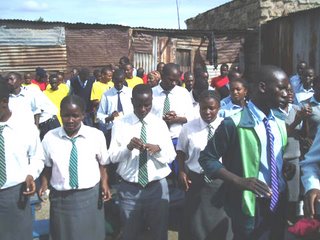 Photo : Isabelle Prondzynski
Photo : Isabelle Prondzynski
haiku members
in a jovial mood as they
eat bread and sodas
welcoming focus
talking as they share jokes
ready to begin
everybody is happy
really to write best haiku --
how wonderful day is it?
Peacocks winning
all the top prizes --
haiku meeting
is this haiku?
why not?
syllables uncountable
this is the day
to share our feelings with mum
before going back
students listening
Madame Isabella speaking
everyone clapping When the meeting was opened, we sang several choruses, praising God, who had brought us this far in our endeavours, and expressing our joy to be together again.
Computing meeting
The first part of the meeting was to recognise the effort the students had made in order to learn computing and encourage them to continue their studies for the final test early next year.
The top 7 computer students, who had passed all modules of their tests, were called forward by the teacher, David Kimani, and congratulated, with small prizes to choose from :
David Caleb Mutua (Peacock)
Omombo Christine (Peacock)
Nyakado Christine (Peacock)
Gideon Gichamba Wangui (Peacock)
Gladys Kathini (Peacock)
Catherine Njeri Maina (Bamboocha)
This brought the Peacocks a round of applause, as they had done exceptionally well. And while I was busy with the prizes, I did not even notice that we were being photographed by Patrick Sensei -- to whom many thanks!
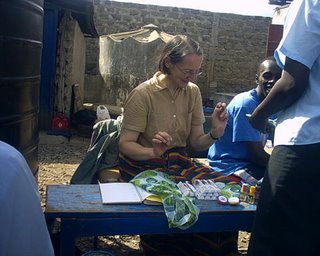 Photo : Patrick Wafula
Photo : Patrick Wafula
Another 17 computer students passed all but one of their modules and were called forward to collect their prizes :
Raymond Otieno (Bamboocha)
Anderson Mwendwa (Falcon)
Boniface Mutua (Falcon)
Ian Kamau (Falcon)
David Wandera (Bamboocha)
Rebecca Mbithe (Oak)
Khadija Rajab (Peacock)
Seline Onguto (Falcon)
Leonard Juma (Falcon
Otieno Walter (Bamboocha)
James Omwimwa (Peacock)
Stephen Kimanthi (Peacock)
Zaccheuas Ogoji (Peacock)
Jacinta Minoo (Peacock)
Ashraf Baraza (Falcon)
Agnes Adwambo (Peacock)
Patrick Gahuo (Falcon)
The computer classes will continue until the beginning of 2007 and will end with a final test, including a practical element. Best wishes to all the students -- and keep up the good work!
Haiku meetingThere followed an open discussion on very many aspects of haiku.
How many syllables, and how to count them?
Can one write about dreams?
How about newspaper or television reports?
What are the kigo of the current season?
Can one write about other seasons?
The importance of observation was emphasised -- concentrating on what is right there, and can be heard, seen, touched, smelled and tasted.
The importance of learning, and of receiving feed-back, was also pointed out. The students proposed that, from time to time, they would send in unsigned haiku, to request and receive feed-back. This was welcomed by everyone as a good idea.
xxxxxxxxxxxxxxxxxxxxxxxxxxxxx
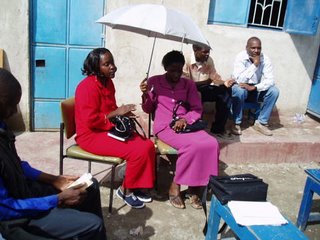 Photo : Isabelle Prondzynski
Photo : Isabelle ProndzynskiThe day, which had started cool and overcast, had meanwhile became hot and sunny, and the time came to close the meeting and for everyone to walk home.
Many of us stayed for another while, to chat and exchange questions, answers and news, before starting on our way back.
Isabelle Prondzynski, November 2006
:::::::::::::::::::::::::::::::::::::::::::::::::::::::::::::::::::::::::::::::::::::::::::::::::::::
A thank-you message to Kenya Saijiki in the evening
Dear Gabi, dear Patrons, dear teachers and haijin,
Thank you most sincerely for the wonderful meeting we had today. You gave generously of your time, and we had a great discussion and enjoyed being together.
Great thanks go to Lucy Irungu and Tujisaidie for the welcome they gave to us and for letting us use the community buildings, where we felt so much at home. Apart from the discussions, we enjoyed music and a light lunch as well as an unexpected mini-ginkoo!
It is hard to express how very much I appreciated the presence and the encouragement by the Haiku Patrons and teachers. I know you are very busy people, particularly at this time of exams, and it is not a given that you can take a whole afternoon out of your schools. Your commitment is wonderful, and the students appreciate it as much as I do! Please receive my gratitude and know that I shall do my utmost to co-operate with you to make the haiku venture a success for all.
You have given the students a wonderful chance! Looking at them today, listening to their eager questions, it is easy to forget that, a year ago, none of them had ever heard of haiku or practised computing and very few had had any contacts with their colleagues in the other schools. This has been a wonderful co-operative success, and the haijin have written so much that is beautiful, inspiring and touching. Dear haijin, if you continue to make progress at this pace, Kenya will soon become one of those countries known internationally to have excellent haiku!
Here are a few of the many haiku written during the day -- thank you, haijin, for the shower of haiku reflecting the day and the season.
my sister is back
with muddy shoes and socks --
my gumboots
Agnes Adhiambo (Peacock)
wet school uniforms
spend days on the line --
students miss schoolDavid Caleb Mutua (Peacock)
children chasing
running everywhere in mud --
looking dirtyAnonymous
dark rain clouds
hanging below the sky --
people buy umbrellas
Paul Brown
raindrops cling on grass
catch the sunbeams sending
lights that dazzle eyesRaymond Otieno (Bamboocha)
graphic and drawings
stuck on the wall --
hey! they are beautiful!Anonymous (Falcon)
Greetings to you all, and profound thanks,
Isabelle.
Feed-back from the Director of WHC WorldkigoDear Friends from Kenya,
whow, this is such a good news indeed!
I forwarded it to all my haiku friends and I will start my day today with a big happy smile !
Thanks to all who help to spread the word of Haiku in Kenya. Dear old Basho and Issa will be pleased to receive this message in their haiku heaven !
With best wishes and may all your plans come true!
GABI
Feed-back from India and the USAGabi sensei, our Director in Japan, had sent my message to her haiku friends in other parts of the world, and some of them responded to send in congratulations.
This is from one of our great haijin friends in India,
Kala Ramesh :
Truly what giant progress in such a short while!
It clearly underlines the effort and selfless love that you've shown
for promoting this art form.
My heartfelt wishes for a grand haiku future in Kenya!
Warmly,
kala
And this is from
William Higginson (we have two of his books!) in the USA :
Quite a decent selection of first results for a new group of haiku recruits! I look forward to seeing more from these and other young Kenyans. Perhaps Dag Hammarskjold's favorite short-poem form will become as much of an ambassador for inter-human understanding as he himself was, or moreso.
I had to particularly smile at the rubber boots poem, watching my two grandsons and Penny's granddaughter and grandson at work and play. (I am an only child, so never had the pleasure (?) of my sibling borrowing my footwear.)
Some of these wouldn't look at all out of place in our magazines.
Congratulations to all involved, including you!
Well done!
Isabelle.
*****************************Related wordsBAHATI Haiku Club, Kenya FALCON Haiku Club, Kenya OAKS Haiku Club, Kenya PEACOCK Haiku Club, Kenya SPIDER Haiku Club, Kenya [ . BACK to WORLDKIGO . TOP . ]:::::::::::::::::::::::::::::::::::::::::::::::::::::::::::::::::::::::::::::::::::::::::::::::::::::


